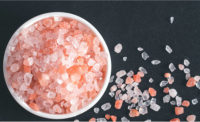Is the trade off for a longer shelf life more chemicals? Not necessarily.
Today’s beef products can truly claim clean labels as they use plant-based solutions such as rosemary extract, green tea extract and clove oil for shelf-life extenders.
Rosemary extract, an antioxidant, is becoming more popular as a shelf-life extender, specifically in ground beef. Its antioxidant qualities help preserve the red color of fresh meat and do not change the taste or smell of the product.
“It is a concentrated source of carnosic acid, which acts as the antioxidant property in the rosemary extract,” says Robert Delmore, Ph.D., a professor in the Department of Animal Sciences at Colorado State University, in Fort Collins, Colo. “When used in a product, the label can simply say ‘rosemary extract’ or may say ‘natural antioxidant.’”
Green tea extract is also being used as an antioxidant in meat, which can prolong shelf life.
Licorice extract and clove oil are also being examined as new plant-based sources of shelf-life extenders.
In addition, the use of supercritical extraction vs. acid extraction has created more potent and useable antioxidants, which have helped with advancing shelf life, says Delmore.
“Openness to non-traditional antioxidants and antimicrobials is a big step in advancing the available technology,” says Delmore. “There’s a lot of emphasis on green products, so there seems to be more ingenuity with identifying sources for natural antioxidants.”
Shelf-life extenders that are made by the fermentation of corn or cane sugar, specifically selected food cultures and vinegar are being developed, as well, he says.
Some companies are also using functional finished goods to extend shelf life, add health benefits, improve flavor and decrease any carcinogenic effects from cooking.
Controlling bacteria
Likewise, shelf-life extenders are being used to improve food safety.
Multiple hurdle technology, such as placing several antimicrobial interventions in meat processing, makes it increasingly more difficult for bacteria to survive and has become a common practice from carcasses to retail packages.
“Fortunately, in the United States, food safety is a non-compete,” Delmore says.
“Therefore, when advances are made, the information is shared throughout the industry.”
Food safety goals for controlling pathogenic bacteria in meat products apply as well to controlling spoilage bacteria, which are the organisms that ultimately decrease shelf life.
“The meat industry uses antimicrobial treatments such as organic acids to reduce pH on the meat to prevent bacterial growth, hot water and steam to kill bacteria and advance chilling methods to keep meat cold, which ultimately reduces the contamination of all bacteria on the meat from the start,” says Delmore.
After the product is packaged, there is little risk of the meat becoming contaminated due to the advanced packaging systems the meat industry has to choose from today.
The meat is typically sealed in a package, either a vacuum package or plastic overwrap, with different combinations of oxygen and gasses.
“The packaging systems today protect the product from outside contamination and oftentimes have technology to extend shelf life in regards to color [i.e. modified atmosphere packaging] and reduce spoilage [i.e. vacuum packaging],” says Delmore.
Making natural extenders affordable
Today, the biggest challenges with shelf-life extenders are maintaining cleaner labels and efficiency in extraction of the shelf-life extenders, he says.
“There is the challenge of producing these cleaner-label natural antioxidants on a larger scale to make available for use at an affordable price for the producer and consumer,” says Delmore.
What’s on the outside matters
Once a product is packaged, the wrap itself helps prolong its shelf life.
Spoilage organisms can be delayed through customized packages that limit or maximize oxygen, control temperature, employ inhibitory gasses and storage time, according to the “Beef Shelf Life” paper for the National Cattlemen’s Beef Association, by Robert Delmore, Ph.D., professor, Department of Animal Sciences, Colorado State University, in Fort Collins, Colo. Here are the most common forms of packaging:
- Vacuum packaging, fresh: The odds are good that most fresh beef primals and subprimals today are vacuum packaged in a bag or pouch. This method keeps bacteria at bay because there is little moisture and oxygen inside the package, enabling meat to stay fresh for about 35 to 45 days, or up to 70 to 80 days in freezing temperatures. The only negative is that without oxygen, the meat’s myoglobin can’t bloom red so it stays purple, which can turn off consumers.
- Vacuum packaging, frozen: Once this meat is packaged and frozen, it has an indefinite shelf life at 0 degrees F. But whole-muscle beef will taste best if it’s defrosted before 12 months.
- Air-permeable overwrap: Most shoppers are familiar with this type of packaging because it remains the most common and economical delivery method for fresh beef at stores. The meat sits on an absorbent pad in a foam tray, wrapped in a clear film that lets in moisture and oxygen. The overwrap allows the meat to turn a nice cherry red, but also leads to a shorter shelf life of three to seven days for whole-muscle beef and less for ground beef.
- Masterpack: Air-permeable overwrap packages are delivered in masterpacks that cannot be breached by oxygen or moisture. The bags have no oxygen and are back-flushed with a combination of carbon dioxide and nitrogen gasses to prevent spoilage. These products remain fresh for 10 to 14 days with a retail shelf life of two to seven days.
- High oxygen: Oxygen works well with carbon dioxide to keep products fresh. This increasingly popular method uses modified-atmosphere packaging to reach a shelf life of 10 to 14 days for ground beef or 12 to 16 days for whole-muscle beef. This product is also placed on a foam or rigid plastic tray, but any residual air is vacuumed out, the package is flushed with a modified atmosphere of oxygen and carbon dioxide and then the package is hermetically sealed.
- Low oxygen N2 and CO2: This packaging creates an even longer shelf life of 25 to 30 days, but because of the lack of oxygen its fresh product remains an unappetizing purple. The nitrogen fills space, while the carbon dioxide prevents spoilage.
- Low oxygen N2, CO2 and CO: To get fresh beef to turn red, these packages employ carbon monoxide to help the myoglobin bloom. The shelf life remains high, as well, with 28 days expected for ground beef and 35 days for whole-muscle beef products. The only drawback is that consumers view the key ingredient, carbon monoxide, as being hazardous, although it is used in a low amount (0.4 percent or less) and poses no risk to the meat or consumer.





Report Abusive Comment